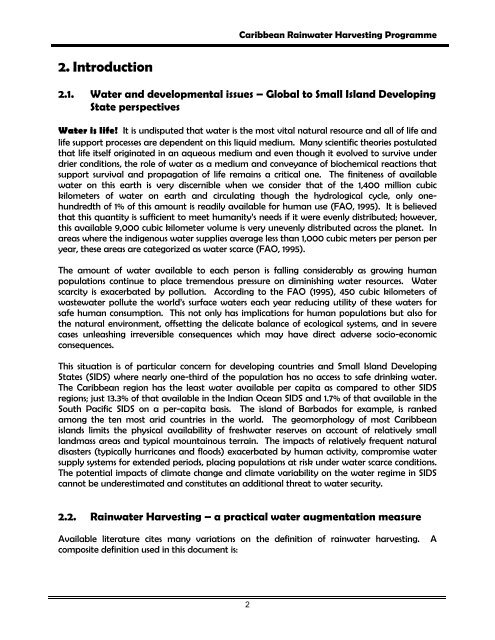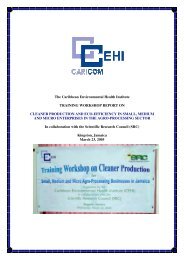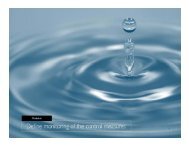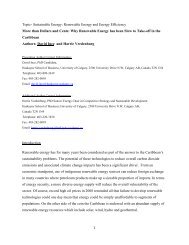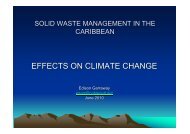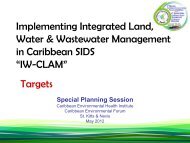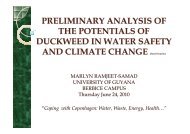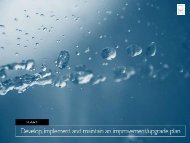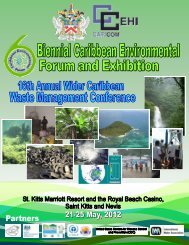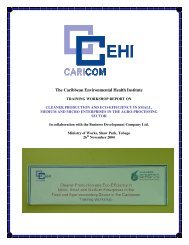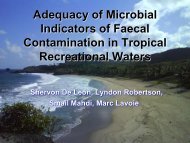A programme for Promoting Rainwater Harvesting in the Caribbean
A programme for Promoting Rainwater Harvesting in the Caribbean
A programme for Promoting Rainwater Harvesting in the Caribbean
Create successful ePaper yourself
Turn your PDF publications into a flip-book with our unique Google optimized e-Paper software.
<strong>Caribbean</strong> <strong>Ra<strong>in</strong>water</strong> <strong>Harvest<strong>in</strong>g</strong> Programme2. Introduction2.1. Water and developmental issues – Global to Small Island Develop<strong>in</strong>gState perspectivesWater is life! It is undisputed that water is <strong>the</strong> most vital natural resource and all of life andlife support processes are dependent on this liquid medium. Many scientific <strong>the</strong>ories postulatedthat life itself orig<strong>in</strong>ated <strong>in</strong> an aqueous medium and even though it evolved to survive underdrier conditions, <strong>the</strong> role of water as a medium and conveyance of biochemical reactions thatsupport survival and propagation of life rema<strong>in</strong>s a critical one. The f<strong>in</strong>iteness of availablewater on this earth is very discernible when we consider that of <strong>the</strong> 1,400 million cubickilometers of water on earth and circulat<strong>in</strong>g though <strong>the</strong> hydrological cycle, only onehundredthof 1% of this amount is readily available <strong>for</strong> human use (FAO, 1995). It is believedthat this quantity is sufficient to meet humanity’s needs if it were evenly distributed; however,this available 9,000 cubic kilometer volume is very unevenly distributed across <strong>the</strong> planet. Inareas where <strong>the</strong> <strong>in</strong>digenous water supplies average less than 1,000 cubic meters per person peryear, <strong>the</strong>se areas are categorized as water scarce (FAO, 1995).The amount of water available to each person is fall<strong>in</strong>g considerably as grow<strong>in</strong>g humanpopulations cont<strong>in</strong>ue to place tremendous pressure on dim<strong>in</strong>ish<strong>in</strong>g water resources. Waterscarcity is exacerbated by pollution. Accord<strong>in</strong>g to <strong>the</strong> FAO (1995), 450 cubic kilometers ofwastewater pollute <strong>the</strong> world’s surface waters each year reduc<strong>in</strong>g utility of <strong>the</strong>se waters <strong>for</strong>safe human consumption. This not only has implications <strong>for</strong> human populations but also <strong>for</strong><strong>the</strong> natural environment, offsett<strong>in</strong>g <strong>the</strong> delicate balance of ecological systems, and <strong>in</strong> severecases unleash<strong>in</strong>g irreversible consequences which may have direct adverse socio-economicconsequences.This situation is of particular concern <strong>for</strong> develop<strong>in</strong>g countries and Small Island Develop<strong>in</strong>gStates (SIDS) where nearly one-third of <strong>the</strong> population has no access to safe dr<strong>in</strong>k<strong>in</strong>g water.The <strong>Caribbean</strong> region has <strong>the</strong> least water available per capita as compared to o<strong>the</strong>r SIDSregions; just 13.3% of that available <strong>in</strong> <strong>the</strong> Indian Ocean SIDS and 1.7% of that available <strong>in</strong> <strong>the</strong>South Pacific SIDS on a per-capita basis. The island of Barbados <strong>for</strong> example, is rankedamong <strong>the</strong> ten most arid countries <strong>in</strong> <strong>the</strong> world. The geomorphology of most <strong>Caribbean</strong>islands limits <strong>the</strong> physical availability of freshwater reserves on account of relatively smalllandmass areas and typical mounta<strong>in</strong>ous terra<strong>in</strong>. The impacts of relatively frequent naturaldisasters (typically hurricanes and floods) exacerbated by human activity, compromise watersupply systems <strong>for</strong> extended periods, plac<strong>in</strong>g populations at risk under water scarce conditions.The potential impacts of climate change and climate variability on <strong>the</strong> water regime <strong>in</strong> SIDScannot be underestimated and constitutes an additional threat to water security.2.2. <strong>Ra<strong>in</strong>water</strong> <strong>Harvest<strong>in</strong>g</strong> – a practical water augmentation measureAvailable literature cites many variations on <strong>the</strong> def<strong>in</strong>ition of ra<strong>in</strong>water harvest<strong>in</strong>g. Acomposite def<strong>in</strong>ition used <strong>in</strong> this document is:2


